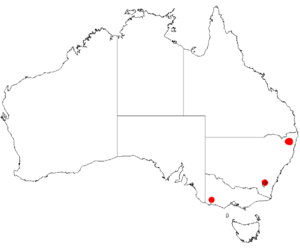Acacia cangaiensis facts for kids
Quick facts for kids Acacia cangaiensis |
|
|---|---|
| Scientific classification | |
| Genus: |
Acacia
|
| Species: |
cangaiensis
|
 |
|
| Occurrence data from AVH | |
Acacia cangaiensis is a special type of wattle tree or shrub. It is found only in a small part of eastern Australia. This plant is also known as a wattle because it belongs to the Acacia family.
Description
This tree or shrub usually grows to be about 2 to 6 meters (6 to 20 feet) tall. Its bark is dark brown and can be smooth or have small cracks. The branches are round and have fine, white to yellow hairs that lie flat against them.
The flowers of Acacia cangaiensis are bright yellow and grow in round clusters. These clusters are about 5 to 7 millimeters wide. Each cluster can have 24 to 43 tiny flowers. You can usually see these flowers between January and March.
After the flowers, flat, leathery seed pods grow. These pods can be straight, curved, or even twisted. They are about 2 to 14 centimeters (0.8 to 5.5 inches) long and 9 to 12 millimeters (0.35 to 0.47 inches) wide.
Taxonomy
Scientists first officially described Acacia cangaiensis in 1991. Two botanists, Mary Tindale and Phillip Kodela, named it. They wrote about it in a science journal called Australian Systematic Botany.
The plant's scientific name, cangaiensis, comes from the Cangai State Forest. This is where the first sample of the plant, called a type specimen, was collected.
Distribution
Acacia cangaiensis grows in a small area of north-eastern New South Wales. You can find it in places like the Gibraltar Range National Park and the Nymboida National Park. This includes the Cangai State Forest.
It often grows in dry sclerophyll forests. These are forests with tough, leathery-leaved plants. It prefers rocky slopes and ridges where the soil is thin and sandy.

